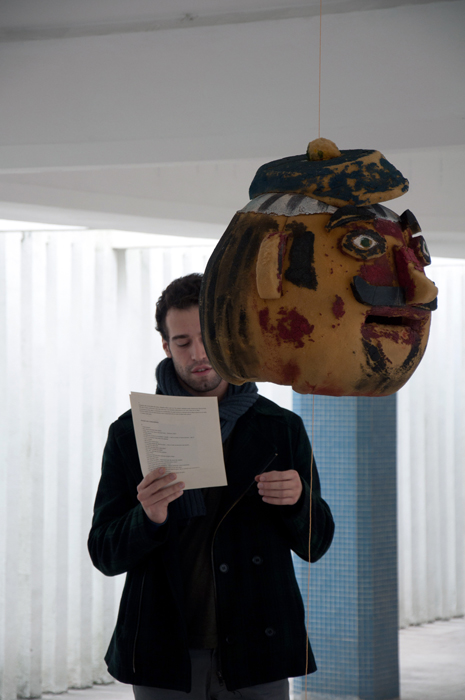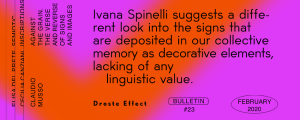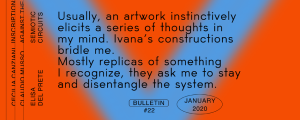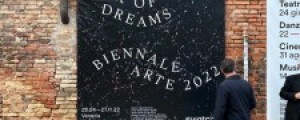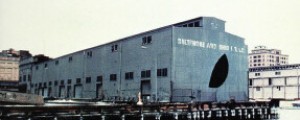A conversation with Musa paradisiaca
Musa paradisiaca (Eduardo Guerra and Miguel Ferrão, 2010) is a long-term discursive project that manifests itself through the different shapes of drawing, performance, and sculpture. It’s a single expression of a collective and fragmented soul, with a variety of competences and voices investigating different (abstract) ideas. An entity continuously informed by the discourse. The project uses narration (storytelling) as a conceptual tool to investigate language as a device capable of building gaps in the complexity of the present.

Musa paradisiaca: Man with really soft hands. Installation view at Galeria Múrias Centeno, 2017. Photo by Bruno Lopes, courtesy of Galeria Múrias Centeno (Lisbon/Porto).
Claudio Zecchi: Musa paradisiaca is a long-term dialogue-based project, which operates in a progressive manner, manifesting itself through different art forms. I think we can speak about Musa paradisiaca by flipping the linear relationship that goes from the biographical towards the work, to obtain a complex circularity where the discursive informs the artwork, which informs the discourse, which informs the artwork, and so on, in a sort of potentially endless and open progress.
If we accept to liberate Musa paradisiaca from a pre-determined form of biography, we can claim that Musa paradisiaca becomes “name” through its own artwork. This means that Musa continuously re-negotiates language in a trajectory that contributes to the birth of a new imagery.
Do you think this could be a possible way to approach Musa paradisiaca’s practice? To constantly re-think Musa’s own boundaries through language?
Musa paradisiaca
Eduardo Guerra: First of all, let us emphasize the fact that we are never alone and that in the very beginning we are at least two heads thinking and doing together. This means that there is a formal, intellectual and affective need for a communal practice, something that can only be born out of a joint will.
In these terms and despite the biographical connotation of our practice, we always face this really powerful fact that we always do together, with and through others, so if there is a biographical aspect, it has to be seen as fictional, tendentious, and at the same time a very real form of biography.
This may seem an abstract idea but what we truly mean, by affirming it, is that we try to convey a sense of livelihood in everything we do, and that we actually see our work as a tribute to the intimate knowledge of things.
As far as it concerns our relationship with the discursive, we are more and more aware that there is a broader sphere of language and that is amplified along the way as it feedbacks and informs discourse again. In this sense, we see everything we do as language, as a way to address and bond with the world.

Left to right:
Fermentation Pot, 2017. Painted polyester resin and fiberglass
Animal-house, 2017, Musa paradisiaca c/ Jorge Bastos and Carlos Paulo. Silkscreen on paper
Asian sofa, 2017. Painted polyester resin and fiberglass
Photo by Bruno Lopes, courtesy of Galeria Múrias Centeno (Lisbon/Porto)
C.Z.: Musa paradisiaca belongs indeed to the dimension of language manifesting itself in this dialectical and mutual tension between discourse and artwork and vice-versa. This means that Musa paradisiaca performs a sort of extended theater in the time and space line. A theatre as a stage to play the possibility or, if you prefer proceeding by paradox, to test the impossibility: the impossibility of being together, the impossibility of a real communication, the impossibility of really hearing each other, the impossibility of being neutral, the impossibility, eventually, to formalize the work.
How do you set up this theater? Which kinds of forms does it take in the time and space length? How does this impossibility –working on an open participative process that keeps continuing even after the formalization of the work, whatever form it takes – go toward the public? And finally, how does this impossibility contribute to continuously verifying the language?
Musa paradisiaca
Miguel Ferrão: Once again, we must recall here a principle that truly exists in every rounded corner of Musa paradisiaca. This principle may well be manifested by the continuously redefined position of the one who is presenting himself, as it may also be embodied by the qualities that this entity is temporarily rendering visible. It is defined, by the close connection between a material body and an oral subject, two characters that, for us, are always the object of a real-time exchange. With this, the simultaneous action of thinking and doing marks, undoubtedly, the place and time of this theatrical relation between things that are and things that once were, gathered in a particular Present. In that sense, the possibility of being together while not sharing the same space and time, through Musa paradisiaca, is the natural condition of its quality of being something alive, i.e., something that unites both objects, entities and occurrences in the actual place where they belong together – a place with no boundaries of language, property or heritage, a place of Now.
C.Z. Revealing itself as a one voice entity, Musa paradisiaca is deliberately implicated (impossibility of neutrality) in the whole process. At the same time, Musa is also responsible for the final choice, the formalization of the work. Have you ever censored any topics? May we address your final choice as an ethical choice?
Miguel Ferrão: Musa paradisiaca has been driven by one specific sort of impossibility, the impossibility of movement without multiplying the points of view, without turning them into parts of one’s body, a body without heads, arms or even eyes, a body of changing appearances and multiple voices. Individuality may not be our main goal, for sure, even though, singularity may be recognized as our collective obsession. There are, although, two faces and two voices to whom we may address to, the two of us, but we are only performing Musa paradisiaca, we can’t be mistaken by it and it can’t be mistaken by us. This leads us to a place where we may only be recognized by a certain way of thinking and by the choices we made along the way. Sometimes, others decide where to go, other times we are the ones pushing them, anyway, what happens with Musa paradisiaca doesn’t stay with Musa paradisiaca.
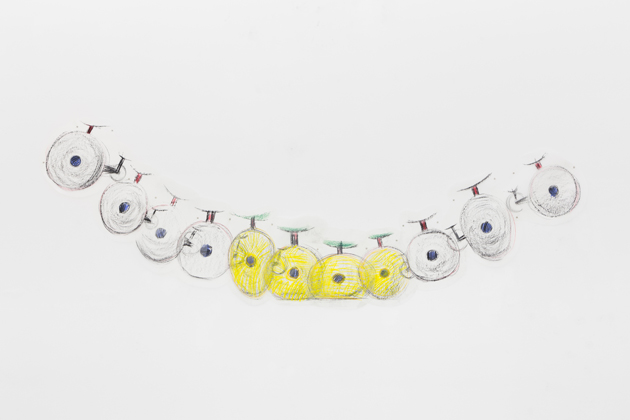
Musa paradisiaca
Borregar [Touch-and-go], 2017
Drawing on plastic film, 110 x 320 cm
Photo by Bruno Lopes, courtesy of Galeria Múrias Centeno (Lisbon/Porto)
C.Z.: Complicity is another key word in your process. Particularly, it refers to the relationship you set up. What do you precisely mean by complicity? Is complicity a way to empower people?
Eduardo Guerra: We prefer to see relationships as something that happens naturally. So, in that sense, we try not to coerce anyone into a “relational” situation, thus trying to force someone to be in a certain way or to act in accordance to something. At the same time, we are really aware that this situation is really common in everyday life, that everyone, to a greater or smaller extent, actually performs a role. Consequently, we take complicity as a broader concept, in the sense that what we actually appreciate is to effectively know something, be it a person, a situation or an object.
Miguel Ferrão: The implication of a voice of those with no voice seems to be included in your question here. As already said, I would add that even if we – Eduardo and I – are the ones publicly appearing under Musa paradisiaca’s name, it is also true that we borrow others’ voices, bodies and capabilities, but not specifically to empower them. We do pay our debt to those entities, in the form of a tribute and its uses, as lived and living examples, transitory moving presences. If there is something to be empowered it’s the possibility of reciprocity between all those in contact with Musa paradisiaca’s activities, i.e. the possibility of everyone involved to address it in a particular mode. If there is someone or something empowered here, I would say that it would be this temporary community of thought, gathered by a free relational agent.
C.Z.: If the object chosen by Musa paradisiaca to manifest its shape in the time and space line is just a possibility among others – a perfect excuse for exteriority, as you claimed – may Musa exist without outcome (only in the process, I would say)?
Eduardo Guerra: Exteriority should be here seen as an intrinsic necessary outcome, in the same way as language and, if we accept language in a broader sense, as manifestation of thought, outcome has to be understood as language as such, be it an object, a conversation, a written letter, and so on and so forth. So, for us, one may say, there is no clear difference between outcome and process, they are both necessary parts of thought itself.
C.Z.: May someone else become Musa paradisiaca? May someone else appropriate your work?
Eduardo Guerra: Of course, that happens frequently, thought is contagious! But so far as someone continuing our practice in the same way we maintain it now, I believe it is quite impossible. Our practice is specifically devoted to self-knowledge, in the sense that it is first of all necessary to us.
C.Z.: «Imagine you are falling. But there is no ground. Many contemporary philosophers have pointed out that the present moment is distinguished by a prevailing condition of groundlessness. We cannot assume any stable ground on which to base metaphysical claims or foundational political myths. At best, we are faced with temporary, contingent, and partial attempts at grounding. But if there is no stable ground available for our social lives and philosophical aspirations, the consequence must be a permanent, or at least intermittent state of free fall for subjects and objects alike [...]».
I think these words by Hito Steyerl fit perfectly with your approach in terms of process, as you just work as some sort of a trigger. For that matter, you deliberately decide to lose control. This act of generosity is a risk, which can lead to failure. Is failure contemplated in your work? If yes, in which terms?
Eduardo Guerra: I would say that our work is less about control and more about dialogue or conversation. So, the openness to chance, risk or failure is fundamental as far as you can only truly discover something if you are actually open to discovery itself.
Miguel Ferrão: As we try our best not to imagine or pre-decide what things could be (actually, they usually appear to us as a return and not as a discovery, as in the relation between past, present and future circumstances that we afterwards find connected), it is mainly a decision of availability that rules our ways of doing and thinking together, among the two of us and with others. The connection between intuition and anticipation may only be performed by a sensorial body willing to discover and to be discovered, with no regrets for secondary, unfocused or intrinsically fearful sensations led by failure, unproductive critical irony or the simple inability to listen.
C.Z.: Your work could be read as a sort of performative investigation (fragmented and precarious) on reality, starting from those abstract ideas that surround us and manifest themselves in books or some other specific objects, both new or already existing. This is, for example, the case of some of the works that you exhibited in your latest solo – Man with really soft hands – at Galeria Múrias Centeno in Lisbon. A sort of extension of your work. This means that the relationship with the reality in its objectification is strongly and continuously re-negotiated in a process that blurs the border of the object itself. A new encounter with the reality as asserted by Badiou in In search of the lost real. How and where do the ideas you want to investigate come from and how do they become universal? How does the object which give shape to the ideas reveal itself (the Capitalist’s hat for example)?
Eduardo Guerra: Nowadays we are quite used to addressing those ideas, that we believe can be universal to some extent, as philosophical intuitions. This sums back to this notion that you don’t need a previous conscience of something to actually discover something. So, if you think about songs, images, or stories, all of them hide these intuitions, or to be more precise, they are animated by these intuitions. In that sense, we tend to see our work more and more as a sort of predisposition for encounter. We could see ourselves as some sort of physicians that try to sensitize and prepare one’s body and mind for what comes.
The “Capitalist’s hat” is a perfect example of that, in the sense that it is casted from a foam hat that was lying around our studio since a performance we did in 2011, The most beautiful party we have ever seen, a sound work being read to a giant foam head representing a commoner, a prop/costume for popular and carnival like presentations. When we prepared that presentation we had another head representing a boss, with a top hat, an almost 19th century like trope of an entrepreneur.
C.Z.: Man with really soft hands witnesses a real experience you had. You were resident in Gwangju (South Korea) and a man asked you to feel his hands to confirm the softness of his skin. How did this experience made on the principle of incredulity inform the whole show?
Miguel Ferrão: We have been in Gwangju quite recently, before Christmas time, last year. This was a very particular experience, as it was the first time we were in Asia. We were invited by Cláudia Pestana — a curator with a long-term connection with South Korea — and Horanggasy Creative Studio — an artist-in-residence art space opened in 2014, located in Yangrimdong, a traditional neighbourhood of Gwangju — to a short, but very intensive stay. This man that we mention in the short text attached to the exhibition at Galeria Múrias Centeno, was our host, inviting us for a first dinner-meeting with him after our long trip. Even before entering the plane we were aware of the communication difficulties that we might face, but we were not expecting that this man would avoid that misunderstanding possibility with such an honest and powerful sense of moment. As soon as we introduced ourselves, he replied with a gesture that would really change the mood of those days we spent together – he offered us his hand and pointed to its palm, asking us to feel it. And so we did it, only to understand that his hands were incredibly soft, as cotton. We would later discover that he was also a man with extreme capabilities to reinvent himself, along his fruitful career in business, as a sort of visionary without false excuses for fail. He is also an inventor of solutions, a man with a complete set of available resources, even concerning material inventions, as the introduction of paper based pastes within his housing construction adventures. This mindset for credibility given to a direct knowledge of things commonly accepted as overlooked (as an invention of a zoo without animals, one of this man’s examples) conjugated with a very personal interpretation of the human nomadic condition and its patterns, was decisive to us. We felt obviously attached to this availability to be sensitive to other’s sensibilities, including those who you would not see afterwards, probably forever (if you are, somehow, a nomad), created an obvious affinity of thought, both mental and material. This encounter was, after all, a meeting with our own previous vivid dreams of pilgrimage, fermentation and communication matters, including a very particular definition of informed surface, as a kind of cutaneous oral event that we evoke in the show.
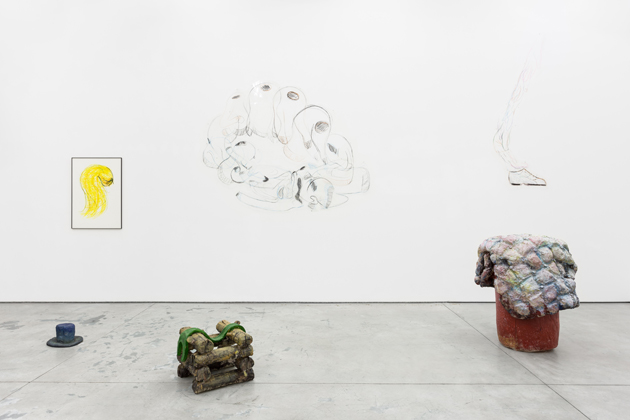
Musa paradisiaca: Man with really soft hands. Installation view at Galeria Múrias Centeno, 2017. Photo by Bruno Lopes, courtesy of Galeria Múrias Centeno (Lisbon/Porto).
C.Z.: You are not sculptors in the strict sense of terms but you use sculpture as a tool, an excuse. Although you are not, the show at Galeria Múrias Centeno evidenced quite clearly a direct reference to “classic” sculpture in terms of feeling light and weight. Is that correct? How important was experimenting with new materials like fiberglass and resin? What is sculpture for you?
Eduardo Guerra: Nowadays it seems but odd to say we are not sculptors in the sense that our work is strongly driven by a sculptural force. At the same time, it is no mystery why we work and think in sculptural terms; sculpture is for us an incredible language we can operate in, a sort of technology that always brings forth an extreme sense of exteriority, not as a projection of thought, but as an actual physical being that conforms outside of us. This exteriority is quite useful, it permits us to address things directly, being on a first or third person sentence. In that sense it creates a dynamic between Miguel, me, and others with whom we might work with, in order to, first of all, articulate meaning.
Historically, we look at sculpture as a technology and even when considering those moments where it seems almost like shape has been denied, we still see those moments quite subjugated to meaning and shape still. This means that a Laocoonte group is no less abstract than a Frank Stella object, or vice-versa. Meaning is there to be operated and to be given criteria by sculpture or to be more precise, by objects.
So, while creating a specific type of materialism, Musa paradisiaca is also creating a specific type of language, and to be able to fully grasp what it means to create objects, one has to see them as a vehicle of thought, or as an extended conversation through and with materials.
For that to be possible, one has to fully know the materials to actually be able to talk to them, to know them by heart, in terms of drives and personality. Just to give an example: fiberglass was first introduced to us last year and it only came into being considered as an actual material for us to use after working at an aerodrome where, as you know, there are really light monoplanes made out of it. As we started working and doing trials with this material, we also discovered this really intense feeling of skin crust, as regenerating surface. So, all of the fiberglass sculptures we do are born out of this mode of enunciation.
by Claudio Zecchi
in Focus on Europe
Apr 14, 2017




